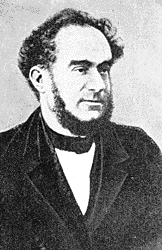Carlo Matteucci facts for kids
Quick facts for kids
Carlo Matteucci
|
|
|---|---|
 |
|
| Born | 20 June 1811 |
| Died | 25 June 1868 (aged 57) |
| Nationality | Italian |
| Alma mater | University of Bologna (PhD) (1829) |
| Known for | Bioelectricity |
| Awards | Copley Medal (1844) |
| Scientific career | |
| Fields | Physics Neurophysiology |
| Institutions | University of Pisa |
Carlo Matteucci (born June 20 or 21, 1811 – died June 25, 1868) was an Italian scientist. He was a physicist and a neurophysiologist. He is famous for being one of the first to study bioelectricity. This is the electricity made by living things.
Contents
Who Was Carlo Matteucci?
Carlo Matteucci was born in Forlì, Italy. His father, Vincenzo Matteucci, was a doctor. Carlo studied math at the University of Bologna. He earned his doctorate degree in 1829. From 1829 to 1831, he studied in Paris, France.
After returning to Italy, Matteucci continued his studies. He worked in different cities like Bologna, Florence, Ravenna, and Pisa. He became the head of a laboratory at the Hospital of Ravenna. He also became a physics professor at a local college there. In 1840, he became a physics professor at the University of Pisa. This happened because his former teacher, François Arago, recommended him.
Discovering Bioelectricity
Carlo Matteucci was very interested in the work of Luigi Galvani. Galvani had studied how electricity affects living things. Starting in 1830, Matteucci began his own experiments. He continued these studies until his death.
He used a very sensitive tool called a galvanometer. This tool measures small electric currents. With it, he showed that injured living tissues, like muscles, create direct electrical currents. He also found that these small currents could add up. This was similar to how Alessandro Volta's "electric pile" (an early battery) worked.
Matteucci even created something he called a "rheoscopic frog". He used a cut nerve from a frog's leg. This nerve, with its attached muscle, could detect tiny amounts of electricity. His work on bioelectricity was very important. It directly influenced other scientists. For example, Emil du Bois-Reymond tried to repeat Matteucci's experiments. This led to the discovery of the nerve's action potential. An action potential is like an electrical signal that travels along nerve cells.
In 1844, Matteucci received the Copley Medal for his important studies. This is a very high award from the Royal Society in London.
Matteucci's Role in Politics
From 1847, Carlo Matteucci also became active in politics. In 1860, he was chosen as an Italian senator. At the same time, he became the main inspector for Italy's telegraph lines. Telegraphs were used to send messages using electrical signals. Two years later, he was made the Minister of Education.
Carlo Matteucci passed away in Livorno, Italy, in 1868.
See also
- Matteucci effect
- Matteucci Medal
- In Spanish: Carlo Matteucci para niños
Images for kids


